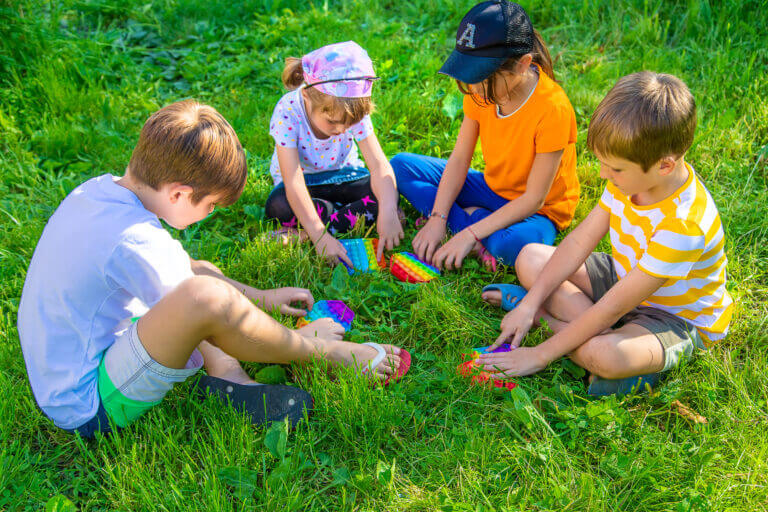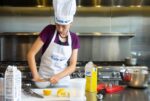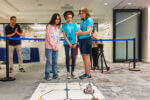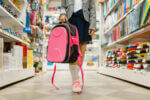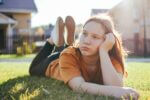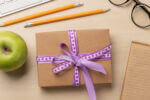Engaging STEM activities don’t have to end when the school year does. Summer is the perfect time to sit down with your child and boost their STEM skills with some exciting hands-on activities. Find the right balance between learning and fun with these ten easy science experiments you can do right at home.
Happy experimenting!
Fizzy Ice
Cool off indoors or out with this cool science experiment. Fizzy ice is a relatively quick and easy activity that will capture your child’s attention. To start, you’ll need a container, baking soda, crushed ice, vinegar, a spoon, and food coloring.
To conduct this experiment, simply pack crushed ice over a mound (or mounds) of baking soda. Mix your vinegar and food coloring and drop it on top of the ice. Then, watch your kids react to the ice as the color combinations come to life.
Teaching science is important, so be sure to explain why this works. The reaction between baking soda and vinegar, in which a bicarbonate (baking soda) and acetic acid (vinegar) produce carbon dioxide gas, accounts for the fizz!
Skittles® Melting Magic
This fun and easy experiment is one kids love. It only requires a plate, warm water, and yummy Skittles®.
First, line your plate with a handful of candies. Next, pour warm water on the plate until the candy is covered halfway. Then, watch as colors stream from the candy into the water.
Why does this work? The coating on the candy is made mostly from sugar and food coloring. Both easily dissolve in water, allowing the colors to diffuse. The different color coatings have different densities which prevents the colors from mixing. For easy clean-up, you can simply eat the candy—we won’t tell!
Magic Milk
Magic Milk is a great experiment made with items that many households already have on hand. All it takes is milk, food coloring, dish soap, and a bowl.
Take a bowl of milk, add a few drops of food coloring in different sections, then drop a tiny bit of dish soap on top of those sections. Watch as the colors burst in the milk!
The proteins and fats in milk are susceptible to changes. When dish soap is added to the mix, the soap molecules try to attach to the milk’s fat molecules. All this molecular motion causes the colors to spread like tiny fireworks. The movement stops when the molecules reach equilibrium.
Rain Cloud in a Jar
Summer weather is a treat, but not everyone enjoys being out in the sun all day. Prepare to bust summer-boredom with some indoor activities. This raincloud-in-a-jar experiment is a great way to visually illustrate a weather event—inside or out!
Gather a glass, water, shaving cream, food coloring, and an eye dropper for this experiment. To start, fill a glass 3/4 full of water, add shaving cream resembling a cloud to the surface, and wait a minute for it to settle. Next, mix a small bowl of water and food coloring to make your rain droplets. Finally, use the dropper to drip the “rain” into the top of the “cloud.” As the cloud fills with water, it will become over-saturated causing it to rain inside the jar. How cool!
Inflate a Balloon
Baking soda and vinegar can be used for lots of experiments. You’ll often see them used in volcano experiments, but did you know you can use them to blow up a balloon? For this experiment, you’ll need an empty water bottle, funnel, baking soda, balloon, and vinegar.
Use the funnel to add baking soda to your balloon, then add vinegar to your empty bottle. Next, attach the balloon to the top of your bottle and lift it upright so the baking soda falls inside the vinegar. Ta-da! Your balloon will inflate due to the acid-base reaction which creates carbon dioxide gas.
Germs
While teaching kids to wash their hands is important, demonstrating the actual “why” presents a great opportunity to teach a valuable life lesson. In this very simple, quick germ experiment, kids will see how good hand-washing helps repel germs.
Grab a plate, water, black pepper, and dish soap. Pour some water on your plate, then sprinkle on lots of black pepper. Be generous! The black pepper represents germs, and we know there are lots of them out there. Next, coat your finger in the dish soap and dip it in the water to see the black pepper spread away. This reaction occurs because the soap lowers the surface tension of the water, causing the water molecules to pull away from the dish soap molecules.
Lemon Battery
Did you know you can power a light with just a couple of lemons? Wow your kids with this cool experiment that demonstrates how a battery works in a simple, hands-on way. You’ll need four lemons, four galvanized nails, four copper pennies or wire, five alligator clips with wires, and a light. Follow the steps below to create your battery.
- Make a small cut in each lemon and insert one nail and piece of copper in each cut. Make sure they don’t touch.
- Connect the end of one alligator wire to a nail in one lemon and connect the other end of the alligator wire to a piece of copper in another lemon.
- Repeat step two until all lemons are connected.
- Connect the last piece of copper (positive) and nail (negative) to your light’s connection.
- Turn on your light!
How does it work? The zinc in the nail and copper are electrodes, and the lemon juice is the electrolyte. All connected, it recreates the chemical reaction that occurs in batteries.
Elephant Toothpaste
When hydrogen peroxide, yeast, and dish soap combine, the result is an exothermic reaction that looks awesome. What’s an exothermic reaction? It’s a chemical reaction that involves the release of energy via heat or light. When hydrogen peroxide combines with yeast, it breaks down into water and oxygen. Oxygen wants to escape the water, but the dish soap traps the oxygen, making the foam! The resulting foam (the elephant toothpaste) is also completely safe to touch and play with, making this a great experiment for children of all ages. Just don’t let your little ones try to brush their actual teeth with it.
Rock Candy Crystals
Did you know rock candy is one of the oldest forms of candy in the world? Learn how crystals grow with a science experiment you can eat! As the crystals grow over the course of a week, kids get an up-close look at sugar crystals on a giant scale.
You’ll need a cup of water, two to three cups of sugar, a jar or glass, a large saucepan, skewers, food coloring, and clothespins. Follow the steps below to get started.
- Dissolve one cup of sugar in one cup of water.
- Add more sugar until it no longer dissolves. Your water should look slightly cloudy.
- Parents, this step is for you. Heat the sugar water until it comes to a simmer, then add your food coloring (optional).
- Turn off the heat and allow the mixture to cool.
- Cut your skewers to size for your jar or cup, dip them in water, and roll them in sugar. Allow them to dry completely. This is important!
- Once your sugar water is cool, pour it into your cup or jar and carefully place the dried sticks inside. Use a clothespin to keep sticks upright and in place. Sticks must not touch the bottom or sides of the jar for the candy to grow.
- Seven days later, taste the results of your experiment!
This process works because by heating the sugar and water, you create a supersaturated solution. That’s when there’s more solute (in this case, sugar) than will dissolve into the liquid. The sugar then comes out of the solution through a precipitation process. As time passes, the water will evaporate slowly from the solution which, in turn, makes it even more saturated. Seed crystals on the sticks allow the rock candy to grow molecule by molecule. Your finished rock candy will be made up of about a quadrillion (1,000,000,000,000,000) molecules. Neat, huh?
Orange Float
Easy, fun, and educational, this buoyancy experiment has it all! And you may already have all the ingredients at home. Plus, kids get to follow the scientific method of developing and testing hypotheses. You’ll need an orange, a large glass or bowl, and water.
Start by filling your bowl or glass with water and then drop in the orange. Will it sink or float? Guess again! Peel your orange and try it one more time. You and your kiddos may be surprised at the results.
Spoiler alert! An orange is heavier with its peel, but since the peel is filled with air pockets, it increases the buoyancy. It’s like a life jacket. Without the peel, the orange sinks.
Visit K12.com to learn how your child can engage in STEM education at a K12-powered school!
